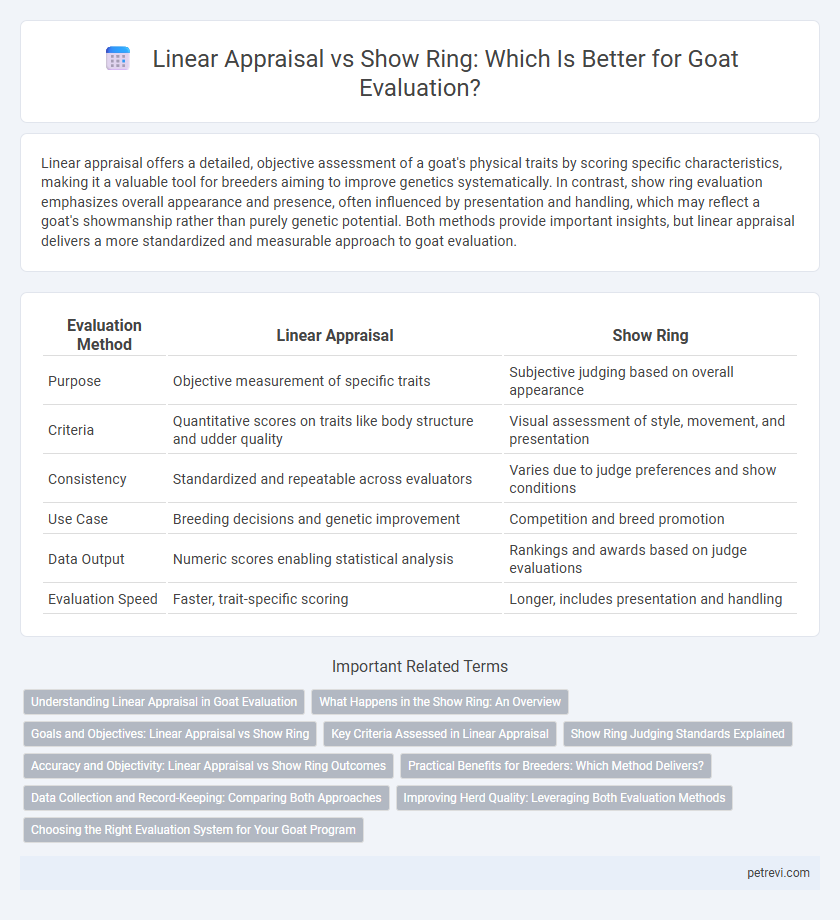Linear appraisal offers a detailed, objective assessment of a goat's physical traits by scoring specific characteristics, making it a valuable tool for breeders aiming to improve genetics systematically. In contrast, show ring evaluation emphasizes overall appearance and presence, often influenced by presentation and handling, which may reflect a goat's showmanship rather than purely genetic potential. Both methods provide important insights, but linear appraisal delivers a more standardized and measurable approach to goat evaluation.
Table of Comparison
| Evaluation Method | Linear Appraisal | Show Ring |
|---|---|---|
| Purpose | Objective measurement of specific traits | Subjective judging based on overall appearance |
| Criteria | Quantitative scores on traits like body structure and udder quality | Visual assessment of style, movement, and presentation |
| Consistency | Standardized and repeatable across evaluators | Varies due to judge preferences and show conditions |
| Use Case | Breeding decisions and genetic improvement | Competition and breed promotion |
| Data Output | Numeric scores enabling statistical analysis | Rankings and awards based on judge evaluations |
| Evaluation Speed | Faster, trait-specific scoring | Longer, includes presentation and handling |
Understanding Linear Appraisal in Goat Evaluation
Linear appraisal in goat evaluation involves assessing specific physical traits such as udder quality, body capacity, and leg structure on a numerical scale, providing objective data to judge breed standards. This method contrasts with show ring evaluations, which rely more on aesthetic presentation and overall impression under competitive conditions. Understanding linear appraisal allows breeders to make informed selection decisions based on measurable traits that influence productivity and longevity.
What Happens in the Show Ring: An Overview
In the show ring, goats are evaluated primarily on their physical appearance, conformation, and presentation according to breed standards, emphasizing traits like body structure, coat quality, and overall health. Judges assess movement, balance, and posture to determine the best examples of each breed, often focusing on immediate visual appeal and showmanship. Unlike linear appraisal, which uses detailed numeric scoring for specific traits, show ring evaluation relies on comparative visual judgment and subjective criteria to rank animals.
Goals and Objectives: Linear Appraisal vs Show Ring
Linear appraisal focuses on detailed genetic trait evaluation, aiming to improve herd performance by identifying specific conformation attributes linked to productivity and health. Show ring evaluation emphasizes overall aesthetic appeal and breed standards, targeting visual excellence and competitive success. Goals of linear appraisal prioritize long-term genetic progress, while show ring objectives center on immediate competitive recognition and ideal physical presentation.
Key Criteria Assessed in Linear Appraisal
Linear appraisal for goats evaluates specific physical traits such as body conformation, udder quality, skeletal structure, and leg correctness, providing detailed scores for each attribute. This method emphasizes measurable, standardized criteria that highlight functional characteristics important for breeding decisions. In contrast, show ring evaluations prioritize overall appearance and presentation, often influenced by subjective judge preferences rather than precise trait measurements.
Show Ring Judging Standards Explained
Show ring judging standards for goats emphasize physical traits such as conformation, muscle mass, and structural correctness under a visual and hands-on assessment by experienced judges. Linear appraisal provides a detailed scoring system based on specific traits measured against breed standards, offering quantifiable data for genetic selection. Show ring evaluation prioritizes overall appearance and presentation, while linear appraisal delivers objective measurements to guide breeding decisions.
Accuracy and Objectivity: Linear Appraisal vs Show Ring Outcomes
Linear appraisal offers a systematic and objective evaluation of a goat's traits by measuring specific physical attributes, ensuring consistent and accurate data across different animals. Show ring judging relies on subjective assessment by experts, which can introduce variability and less quantifiable outcomes in goat evaluation. Studies indicate linear appraisal provides more reliable accuracy in identifying genetic potential, while show ring results often reflect aesthetic preferences and presentation skills.
Practical Benefits for Breeders: Which Method Delivers?
Linear appraisal provides breeders with precise, quantifiable data on goats' physical traits, enabling targeted genetic selection and improvements in herd quality. Show ring evaluations offer real-time assessment of overall animal conformation and presentation, highlighting market appeal and breed standards. Practical benefits favor linear appraisal for long-term breeding decisions, while show ring success boosts immediate sales and reputation.
Data Collection and Record-Keeping: Comparing Both Approaches
Linear appraisal involves systematic data collection on specific traits such as stature, udder quality, and body capacity, enabling objective and quantifiable record-keeping to track genetic progress over time. Show ring evaluation relies more on subjective judgment by judges assessing overall appearance and presentation, which can lead to less consistent data collection and record accuracy. Emphasizing linear appraisal enhances precise, repeatable records that support breeding decisions and long-term herd improvement.
Improving Herd Quality: Leveraging Both Evaluation Methods
Linear appraisal provides precise data on a goat's physical traits, enabling targeted genetic improvement and informed breeding decisions. Show ring evaluation offers real-time assessment of overall conformation, movement, and temperament, highlighting traits that appeal to breed standards and judges. Combining both methods enhances herd quality by merging objective trait analysis with practical, competitive assessment, leading to more robust and well-rounded breeding programs.
Choosing the Right Evaluation System for Your Goat Program
Choosing the right evaluation system for your goat program depends on specific breeding goals and management style. Linear appraisal provides objective, detailed trait measurements that help identify genetic strengths and weaknesses, supporting long-term herd improvement. Show ring evaluations emphasize conformation and presentation, offering immediate feedback on an animal's overall appearance but may be influenced by subjective judging criteria.
Linear appraisal vs Show ring for Goat evaluation Infographic

 petrevi.com
petrevi.com